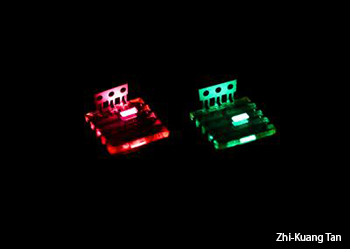
Perovskite-powered LEDs in red and green.
Perovskites—materials with a crystal structure similar to minerals found in Earth’s mantle and some meteorites—have recently gained headlines as a promising component for a new class of solar cells. Scientists in the U.K. and Germany have now extended the potential reach of perovskite technology indoors, demonstrating new, bright LEDs based on the material (Nat. Nanotech., doi:10.1038/nnano.2014.149). The team believes that the demonstration opens the door to a low-cost, color-tunable approach to LED development for a wide range of applications.
The perovskites in question are organometal halide perovskites, a combination of lead, organics and halogens that arrange into perovskite crystal structure in the solid state. Research over the past several years has revealed that these materials have excellent semiconducting properties for optoelectronic devices, such as photovoltaic cells. In addition, the material is potentially cheap and easy to work with, as the component elements can be solution-processed and dried into perovskite crystals.
Spurred by the material’s success in photovoltaics, researchers have tried to press the same qualities into service to create light-emitting devices using perovskites. Those efforts, however, have only achieved electroluminescence at liquid-nitrogen temperatures—not exactly the best setting for a workhorse LED.
To create a more practical perovskite LED, researchers at the University of Oxford and the University of Cambridge, U.K., and Ludwig-Maximilians-Universität München, Germany, sandwiched a 15 nm thick layer of organometal halide perovskite between two large-bandgap semiconductors: a 25 nm thick layer of TiO2 (deposited atop an indium tin oxide cathode) at the bottom and a 50 nm thick F8 polymer layer (crowned by an MoO3/Ag anode) at the top. The double-heterostructure architecture was designed to confine injected charges into the very thin layer of perovskite, thereby improving its light emission. With that basic configuration, the team was able to coax bright electroluminescence out of the structure, at room temperature, in the near-infrared, red and green, with the color tunable by varying the halide composition in the perovskite.
The researchers believe that the combination of easy fabrication and the tunability into a variety of colors could make the technology a good fit with consumer applications such as flat-panel displays; they are also looking at boosting the structure’s efficiency for possible use in diode lasers. The first commercial perovskite-based LEDs could, they suggest, show up on the market within five years.
